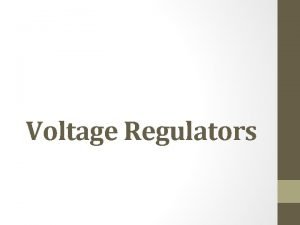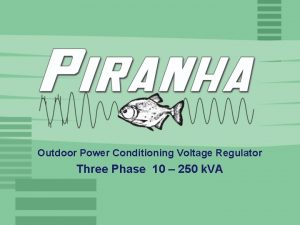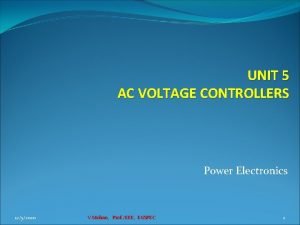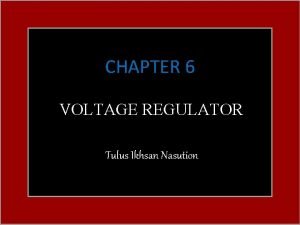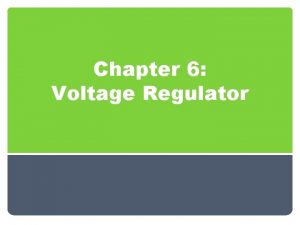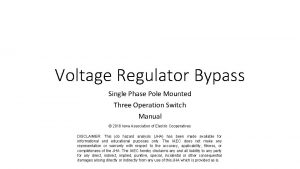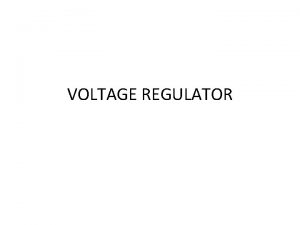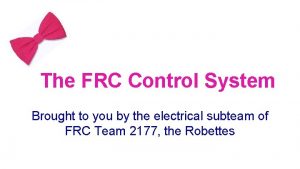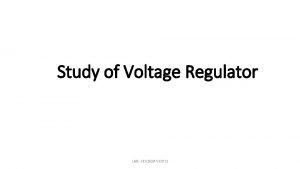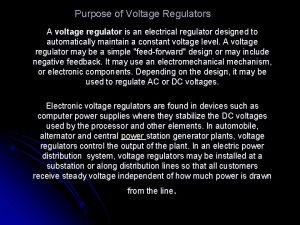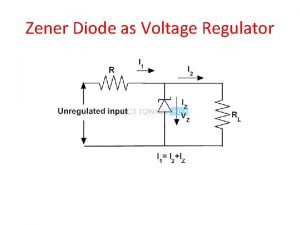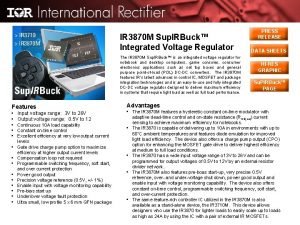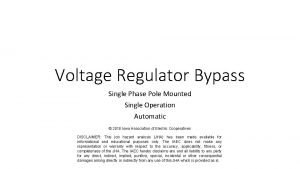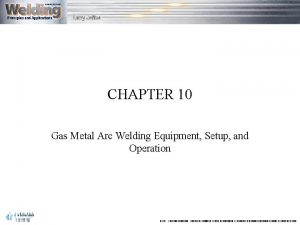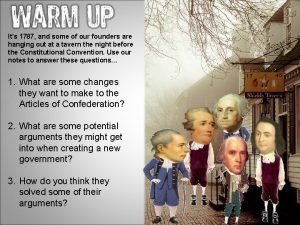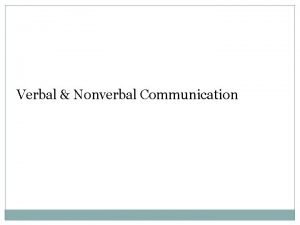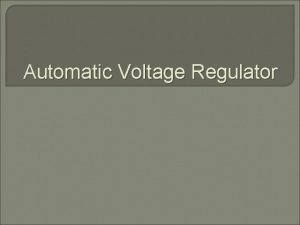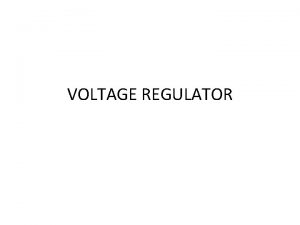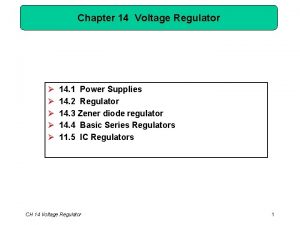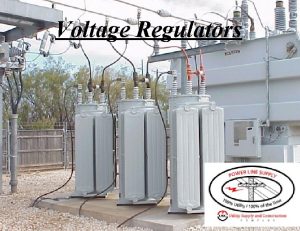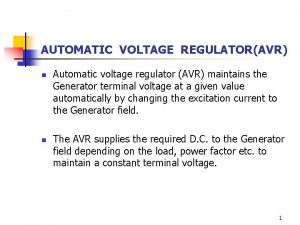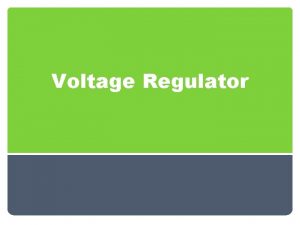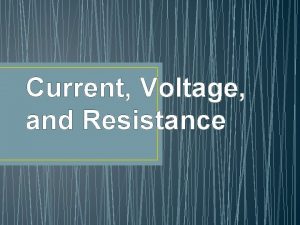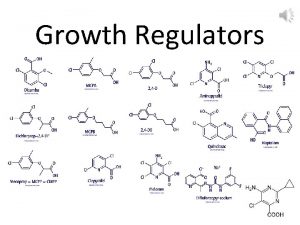Voltage Regulators Power Supplies Voltage regulator keeps the





















- Slides: 21

Voltage Regulators

Power Supplies

Voltage regulator • keeps the output voltage constant • in spite of changes in load current or input voltage. Factors Affecting the Load Voltage The load current (IL): The line voltage : The temperature

Power Supply Performance Parameters Load Regulation • The load regulation is denoted as LR • VNL = Load voltage with no load current • VFL = Load voltage with full load current Regulation characteristics 0%, which is the best expected

Question: • A dc voltage supply provides 60 V when the output is unloaded. When connected to a load, the output drops to 56 V. Calculate the value of voltage regulation. (load regulation)

Line Regulation or Source Regulation The SR is defined as the change in the regulated load voltage for a specified range of line voltage, VHL = load voltage with high line voltage VLL = load voltage with low line voltage Vnom = nominal load voltage

Question: • For a particular power supply, the load voltage is 10 V ± 0. 3 V for a line voltage of 230 V ± 10 %, calculate source regulation and percentage source regulation. • • VHL = 10 + 0. 3 = 10. 3 V VLL = 10 - 0. 3 = 9. 7 V SR = VHL - VLL = 10. 3 - 9. 7 = 0. 6 V Vnom= 10 V

DISCRETE TRANSISTOR VOLTAGE REGULATION 1. the series voltage regulator and 2. the shunt voltage regulator.

Series Voltage Regulation • If the output voltage increases, • the comparator circuit provides a control signal to cause the series control element to decrease the amount of the output voltage • If the output voltage decreases, • the comparator circuit provides a control signal to cause the series control element to increase the amount of the output voltage.

Emitter-follower Type Regulator Basic working Transistor Q 1 is the series control element, Zener diode DZ - the reference voltage. Ø If the output voltage decreases, Ø the increased VBE causes transistor Q 1 to conduct more, Ø thereby raising the output voltage Ø If the output voltage increases, Ø the decreased VBE causes transistor Q 1 to conduct less, Ø thereby reducing the output voltage

Emitter-follower Type Regulator

Question: • Calculate the output voltage and Zener current in the regulator circuit of Fig.


IMPROVED SERIES REGULATORCONTROLLED TRANSISTOR SERIES REGULATOR(NEGATIVE FEEDBACK REGULATOR) If the output voltage tries to increase, • increased voltage V 2, causes the VBE 2 up(since VZ remains fixed). • If Q 2 conducts more current, • less goes to the base of transistor Q 1, • which then passes less current to the load, reducing Vo • thereby maintaining the output voltage constant.

OVERLOAD PROTECTION – SHORT CIRCUIT PROTECTION • CURRENT LIMITING CIRCUIT • With transistor • With diodes Disadvantage : -large power dissipation in the series pass transistor

OVERLOAD PROTECTION – SHORT CIRCUIT PROTECTION • FOLDBACK CURRENT LIMITING

OVERLOAD PROTECTION – SHORT CIRCUIT PROTECTION • FOLDBACK CURRENT LIMITING

SHUNT VOLTAGE REGULATION • If the load voltage tries to change due to a change in the load, Ø the sampling circuit provides a feedback signal to a comparator, Ø which then provides a control signal to vary the amount of the current shunted away from the load.

BASIC TRANSISTOR SHUNT REGULATOR Ø If the load resistance decreases, Ø a reduced drive current to the base of Q 1 results, Ø shunting less collector current. Ø The load current is thus larger, thereby maintaining the regulated voltage across the load.

Question: • Determine the regulated voltage and circuit currents for the shunt regulator of Fig.

 Transistor series voltage regulator
Transistor series voltage regulator Outdoor voltage regulator
Outdoor voltage regulator Ac regulators in power electronics
Ac regulators in power electronics Shunt voltage regulator using op-amp
Shunt voltage regulator using op-amp Types of regulator
Types of regulator Pole mounted voltage regulator
Pole mounted voltage regulator Pzmax
Pzmax Pdp frc
Pdp frc Ic 723 pin diagram
Ic 723 pin diagram Integrated voltage regulator
Integrated voltage regulator Ac voltage regulator using triac
Ac voltage regulator using triac Zener diode as voltage regulator
Zener diode as voltage regulator Fully integrated voltage regulator
Fully integrated voltage regulator Pole mounted voltage regulator
Pole mounted voltage regulator Frc main breaker
Frc main breaker Buried arc transfer definition
Buried arc transfer definition Commercial power supplies
Commercial power supplies Automated business power
Automated business power Regulators apush
Regulators apush Regulators billy the kid
Regulators billy the kid North american gaming regulators association
North american gaming regulators association Function of verbal communication
Function of verbal communication
